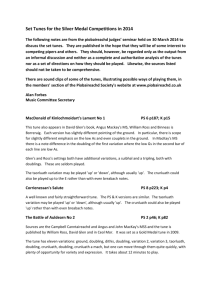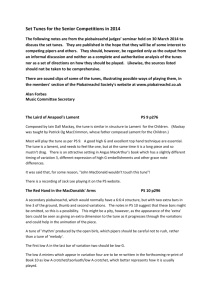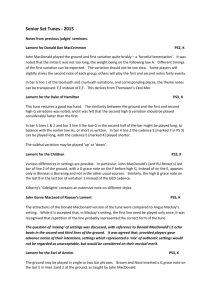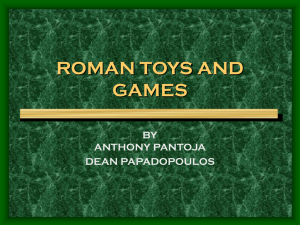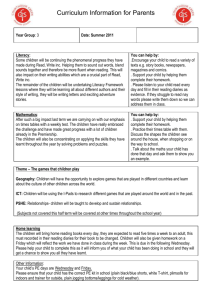Notes on 2014 Gold Medal Tunes
advertisement
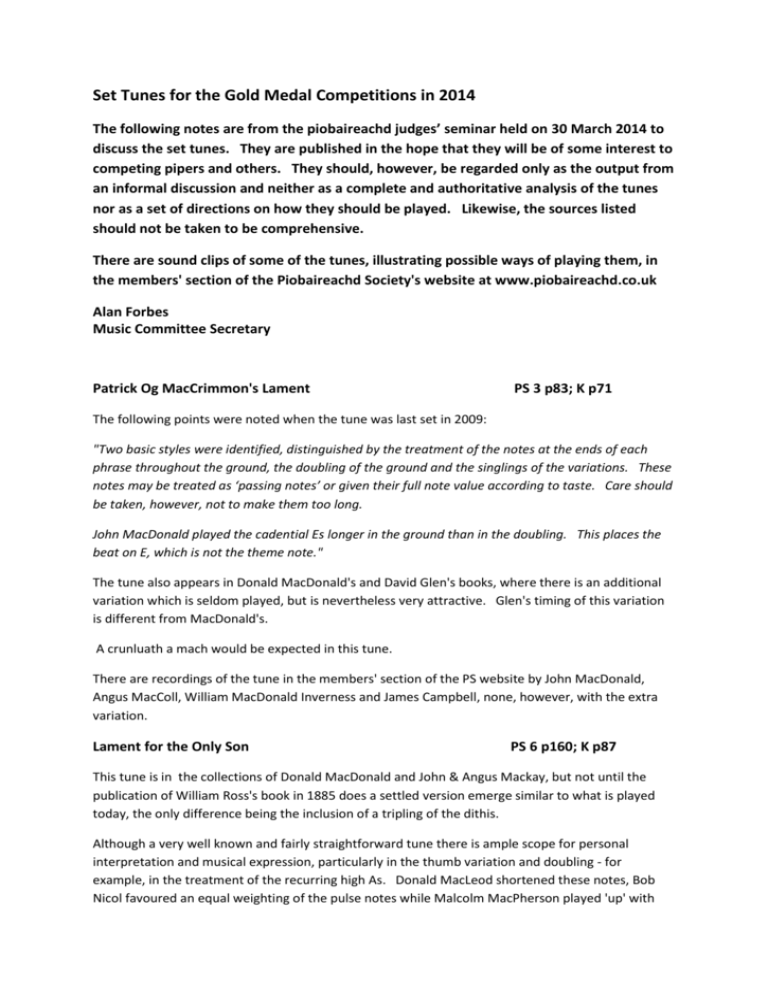
Set Tunes for the Gold Medal Competitions in 2014 The following notes are from the piobaireachd judges’ seminar held on 30 March 2014 to discuss the set tunes. They are published in the hope that they will be of some interest to competing pipers and others. They should, however, be regarded only as the output from an informal discussion and neither as a complete and authoritative analysis of the tunes nor as a set of directions on how they should be played. Likewise, the sources listed should not be taken to be comprehensive. There are sound clips of some of the tunes, illustrating possible ways of playing them, in the members' section of the Piobaireachd Society's website at www.piobaireachd.co.uk Alan Forbes Music Committee Secretary Patrick Og MacCrimmon's Lament PS 3 p83; K p71 The following points were noted when the tune was last set in 2009: "Two basic styles were identified, distinguished by the treatment of the notes at the ends of each phrase throughout the ground, the doubling of the ground and the singlings of the variations. These notes may be treated as ‘passing notes’ or given their full note value according to taste. Care should be taken, however, not to make them too long. John MacDonald played the cadential Es longer in the ground than in the doubling. This places the beat on E, which is not the theme note." The tune also appears in Donald MacDonald's and David Glen's books, where there is an additional variation which is seldom played, but is nevertheless very attractive. Glen's timing of this variation is different from MacDonald's. A crunluath a mach would be expected in this tune. There are recordings of the tune in the members' section of the PS website by John MacDonald, Angus MacColl, William MacDonald Inverness and James Campbell, none, however, with the extra variation. Lament for the Only Son PS 6 p160; K p87 This tune is in the collections of Donald MacDonald and John & Angus Mackay, but not until the publication of William Ross's book in 1885 does a settled version emerge similar to what is played today, the only difference being the inclusion of a tripling of the dithis. Although a very well known and fairly straightforward tune there is ample scope for personal interpretation and musical expression, particularly in the thumb variation and doubling - for example, in the treatment of the recurring high As. Donald MacLeod shortened these notes, Bob Nicol favoured an equal weighting of the pulse notes while Malcolm MacPherson played 'up' with the emphasis on the high As. Again in both singling and doubling of this variation one hears the opening notes of phrase one (GEA) played cut to low A and the other way around. Malcolm MacPherson also played rather open grip movements in the ground, in contrast to the much tighter style usually played today. Binneas and others emphasise the cadence Es whereas others play them very short. A crunluath a mach is indicated in PS 9 and would normally be expected in this tune. His Father's Lament for Donald MacKenzie PS 9 p273 The first published version of the tune was in Thomason's Ceol Mor. This includes an extra variation and doubling in what is already a long tune! Further MS versions are found in the papers of David Glen and Robert Meldrum. A distinguishing feature of this beautiful tune are the F grace notes in the second variation and doubling, usually played quite openly. Several of the MS sources and Ceol Mor show these as melody notes, albeit short 'passing' notes. At one time these appeared in many tunes but now have died out, with only a few exceptions. Another feature of the tune is its length, which is probably the reason that it is not played more often in competitions. The cadence entry to the doubling of variation two is probably an error and may be replaced by a simple G grace note, as in the later variations. James Campbell did not play the cadences in the singlings either. Other possible differences might be in playing the taorluath variation 'up' rather than 'down' (Glen shows it 'up') and the crunluath variation may be played with the breabach notes more or less even if the taorluath is played 'up' or with a slight weight on the first if the taorluath is played 'down'. There is a recording of the tune by John Don Mackenzie on the PS website. MacNeill of Barra's March PS 10 p314 The main sources are the Campbell Canntaireachd and Angus MacArthur. The MacArthur setting may be found in 'The Music of Scotland - The MacArthur MacGregor Manuscript of Piobaireachd (1820)' published by the Universities of Glasgow and Aberdeen. Most are likely to play the PS 10 setting. Some minor differences in timing are possible e.g. in bar 1 of the ground some emphasise the first C while others play it evenly with the following low A. In the last two bars of the doubling of variation two the low As before the taorluaths may be played short, in keeping with the timing of the rest of the variation, or long as shown. There are some fairly obvious errors in line 3 of the doubling of variation two in PS 9. There should be pause marks over the D in bar 2 and the C in bar 4 and a couple of the tripling notes only have two dashes under them. The MacArthur ground has some note differences and omits the last two bars in each variation - the repeated hiharins, taorluaths and crunluaths. Variation 1 is written 'down' which is an attractive contrast to the rest of tune which is 'up'. The crunluath fosgailte is played 'open'. There is a recording of the tune by Murray Henderson on the PS website.
